VISIT TOTNES CASTLE WITH ENGLISH HERITAGE MEMBERSHIP
- Up to 6 Kids go free
- Free Parking at English Heritage
- Receive our Handbook
- Unlimited access to over 400 days out

TICKETS & PRICES
Adults: £6.50
Children 5-17 Years: £3.90
Families (2 adults, up to 3 Children): £16.90
Families (1 adult, up to 3 Children): £10.40
Quick Navigation
Visiting Totnes Castle
Totnes Castle is a 13th century Norman motte and bailey castle and replaced an earlier wood and earthwork castle built in 1067. The castle served a limited military role and was more of an administrative seat. Today, visitors may explore the ruins and climb the keep to enjoy the views over Totnes town.
Parking
Totnes castle doesn’t have a designated car park, but visitors may use the Limited Pay and Display parking 64 metres (210 ft) from the site. Take Station Road and turn south onto Castle Street signposted as "Historic Town Centre." Then turn left onto North Street and follow the easy route marked by the heritage signs.
Price
English Heritage encourages visitors to book their time slot before they visit via their online booking portal. Booking online also ensures that you receive the pre-booking discount, and prices may be higher at the on-site ticket office.
|
English Heritage Society members |
Free entry with membership card |
|
Adults |
£6.50 |
|
Children (age 5-17) |
£3.90 |
|
Concession |
£5.90 |
|
Family (2 adults and up to 3 children) |
£16.90 |
|
Family (1 adult and up to 3 children) |
£10.40 |
Opening
English Heritage posts their weekly timetable for visitors on the Heritage website. Typically the site is open Monday to Sunday, 10 a.m. to 5 p.m.
Location and Access
Totnes Station is only ¼ mile (402 m) from the castle, and there are plenty of public parking sites in town to use. Visitors should follow Station road and turn south into Castle Street. The castle rests in the centre of the town and is signposted by brown heritage signs.
The address of Totnes Castle is:
Castle Street
Totnes
Devon
TQ9 5NU
Visitors may climb the castle keep and enjoy the view over Totnes and the River Dart. The inner bailey offers a grassed area with mature trees, where you may enjoy a picnic. You may explore the steep-sided ditch that flanks the castle keep which once defended the mighty Norman stronghold.
Those with mobility restrictions should note that only the inner bailey is wheelchair accessible as the motte and keep standing on a steep slope with 70 uneven stone steps. The moat is also not wheelchair accessible as the paths are narrow and uneven in places. The castle paths are loose gravel interspersed with grass.
Know Before You Go
- Visitors will find a small gift shop on the castle grounds.
- Heritage provides several picnic tables and benches, or you may picnic on the grassed lawn.
- The site has no public toilets, and the nearest facilities are in Market Street off Totnes High Street.
- Heritage welcomes dogs on a leash and provides pet owners with dog waste facilities and an on-site dog water bowl.
- Visitors may buy soft drinks from the ticket office.
- Pushchairs are welcome, but the access to the keep is steep and has 70 stone stairs.
- Visitors can climb the keep and enjoy the view of the surrounding area.
Places To Stay Nearby
The Old Forge Hotel Totnes
Set in a charming 600-year-old building, The Old Forge Hotel offers ten comfortable rooms just minutes from Totnes town centre. This lovingly restored stone building once housed the local blacksmith, and an upstairs room once functioned as a lock-up cell and courtroom for local miscreants.
The quaint site offers bed and breakfast, WiFi, Freeview TV and ensuite bathrooms. Many of their rooms have their own outside garden and patios; otherwise, you can enjoy the south-facing country garden. Room rates per night start at £125 for a standard double room.
The Steam Packet Inn
Situated right on the banks of the River Dart, the Steam Packet Inn offers six newly renovated en suite rooms. This 19th-century historic building dates back to the 19th century and is named after the steamboat that brought the mail to Totnes via the River Dart.
The cosy in-house bub and a restaurant serve local fare, while their rooms provide accommodation for singles, couples and family rooms. The hotel is a great base to explore the history of the once-thriving Saxon town. Room rates per night start at around £115.
Premier Inn Paignton Seafront (Goodrington Sands) Hotel
The Paignton Premier Seafront Hotel offers sea views and a host of area attractions right on the doorstep. The inn stands on the beach close to the famous Paignton Zoo, Dartmouth Steam Railway and Quaywest Waterpark, which is excellent for families and the young of heart alike. The hotel is also near the major routes leading to nearby historical attractions, including Totnes Castle.
The rooms come equipped with WiFi and TVs as well as en suite bathroom facilities. Breakfast is optional with the room price, or you can try the in house restaurant and bar facilities. Rooms start at around £81 to £137, depending on your package choice.
History of Totnes Castle
A Breton Knight named Juhel built the first wood and earth fort in 1067 amid a Saxon burgh. One of William I's generals, Juhel, built Totnes castle to subdue local rebellion. The 14th century stone shell served a limited military function and fell to ruin in the 1600s.
Time Line
-Pre Norman Conquest
Totnes was once a bustling Saxon burhs found in Devon, and the town occupied a vital site. The town stood near the lowest point of crossing of the River Dart, which provided sea access and linked with a crucial Roman road and trading route to the surrounding towns.
After the Norman invasion, the local populace rebelled against the rule of the newly appointed King William I prompting him to embark on a relentless campaign to subdue the local people.
-1067 (First Castle)
The Normans seized Totnes for its strategic importance and as a show of power against the rebellious Saxon South East. William I granted the land to one of his Norman allies, a Breton Knight named Juhel.
Juhel constructed his first motte and bailey fortress of earthwork and wood on a raised ground, commanding the head of the navigable reaches of the River Dart. As a show of power, he built the fort over the northwest corner of the Saxon Town, destroying the Saxon houses in his path.
By imposing the grand fortress amid the Saxon stronghold, he stamped his dominance over the local populace.
-1086 (Exile)
Juhel made Totnes his seat of power, from which he commanded over 100 manors in Devon. However, his fortunes faded when William II forced Juhel into exile in 1086 and seized his castle and estates.
Historians believe that Juhel supported a rebellion against William II, leading to his banishment from his seat of power. William II granted Totnes and the motte and bailey castle to his trusted allay Roger de Nonant.
-1205 (Treason)
Although historians believed the site remained unoccupied, the castle and estates remained in the Nonant line for three generations. In 1205 William de Braose, 3rd Lord of Bramber, claimed the castle and lands as a descendent of Juhel.
However, his fortunes too became overturned as King John I suspected him of treason, seized the castle, and granted it to Henry, the Earl of Cornwall.
Historians believe Reginald de Braose, Willam de Broase's son, rebuilt the first wooden keep in stone. He built the first stone shell keep and enlarging the keep, and providing stone walls. From this point, the castle saw little military use and became an administrative seat of power instead. The town itself was in decline as their significant tin industries and cloth moved to other ports.
-1326 (Rebuild)
The de la Zouch family took ownership of Totnes Castle and Conducted repair work under the command of the Crown. They refortified the site with a new shell kept using Devonian limestone and red sandstone, first and appointed a constable as custodian.
-1485
Under new Tudor rule following the war of the Roses, the Crown reallocated the castle from the Yorkist de la Zouche family to the Lanacasrian Sir Richard Edgecomb. The castle began to decline along with the surrounding town and fell into disrepair.
-1645 (Slighted)
Totnes Castle once more provided a military function when the Royalists occupied it with a garrison. However, Sir Thomas Fairfax and his forces laid waste to the castle as he headed his campaign through Dartmouth.
-1764
Edward Seymour, the 9th Duke of Somerset, brought the now ruined castle back into his family. The family maintained the site, even adding a tennis court and tea rooms in the 1920s and 30s.
-1947
The current Duke of Somerset granted the castle site to the Ministry of Works (later known as English Heritage, who still care for the site today.
Totnes Castle Occupants
- 1067- Juhel, the Norman Knight, built and occupied the first Totnes Castle
- 1083- Roger de Nonant occupied the castle.
- 1205- William de Braose, 3rd Lord of Bramber, reclaimed the castle as a descendent of Juhel but is unlikely to have resided in the castle. His son Reginald de Broase likely built the first stone castle on the site.
- 1326- The de la Zouch clan took ownership of the castle and extensively rebuilt the structure.
- 1485- Sir Richard Edgecomb took ownership of the castle.
- 1764- Edward Seymour, the 9th Duke of Somerset and his family, occupy the site adding leisure facilities such as a tennis court and tea room.
Images of Totnes Castle
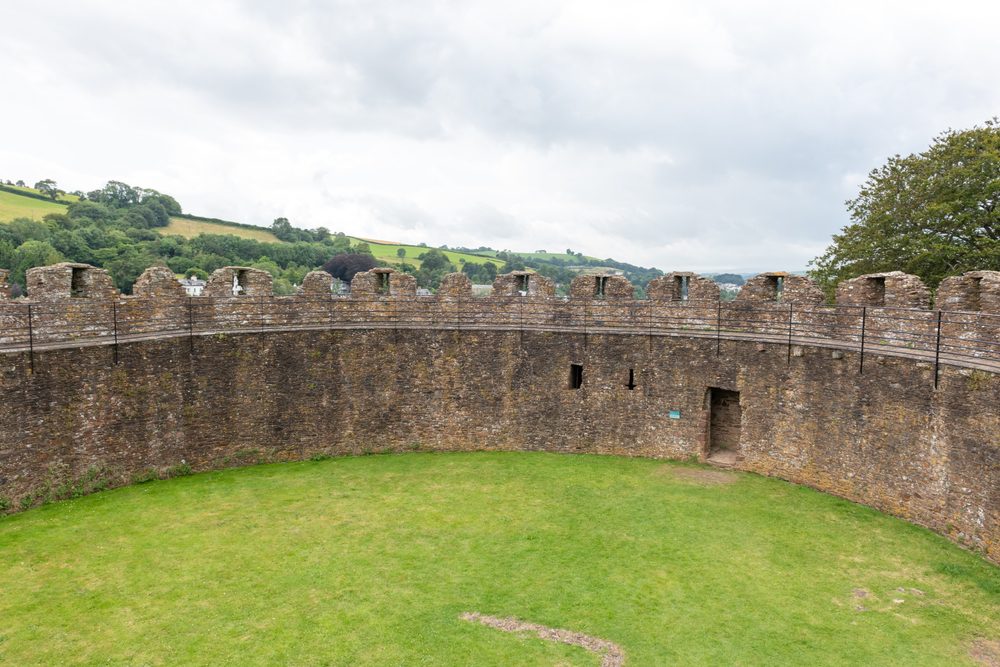
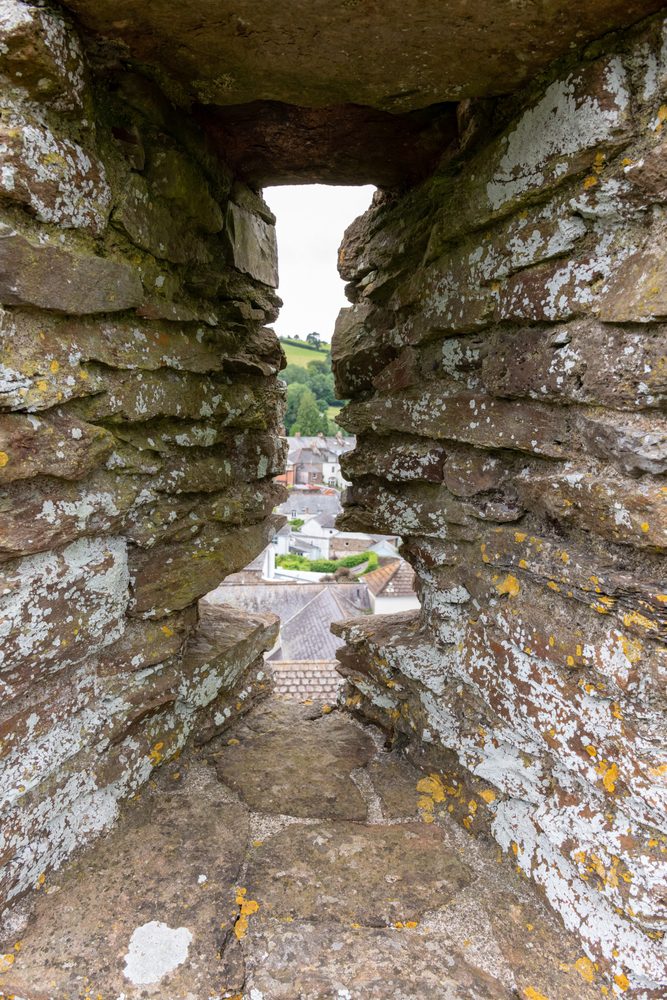
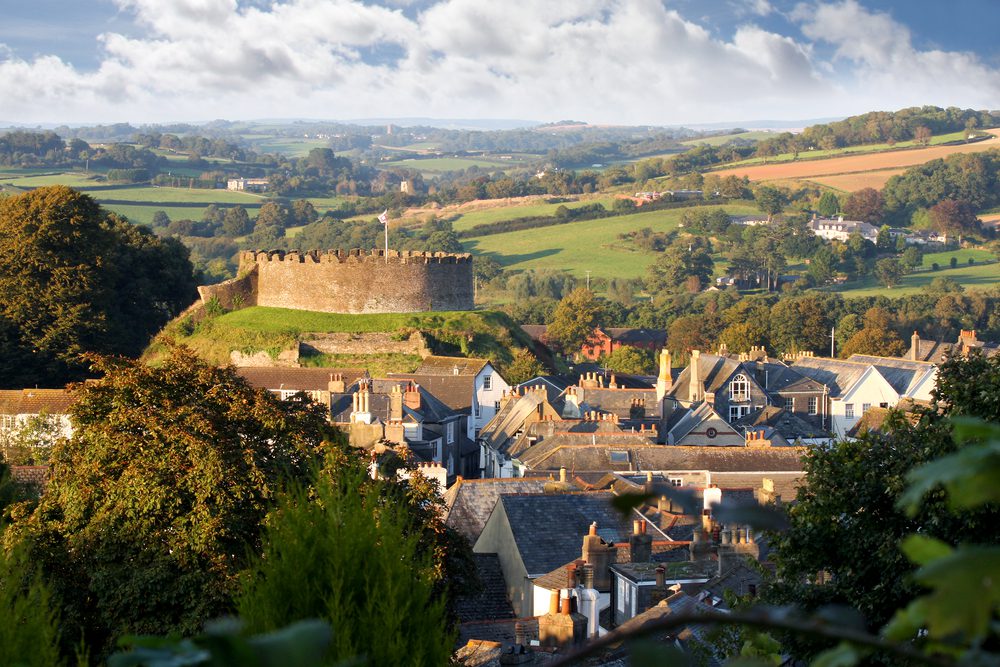
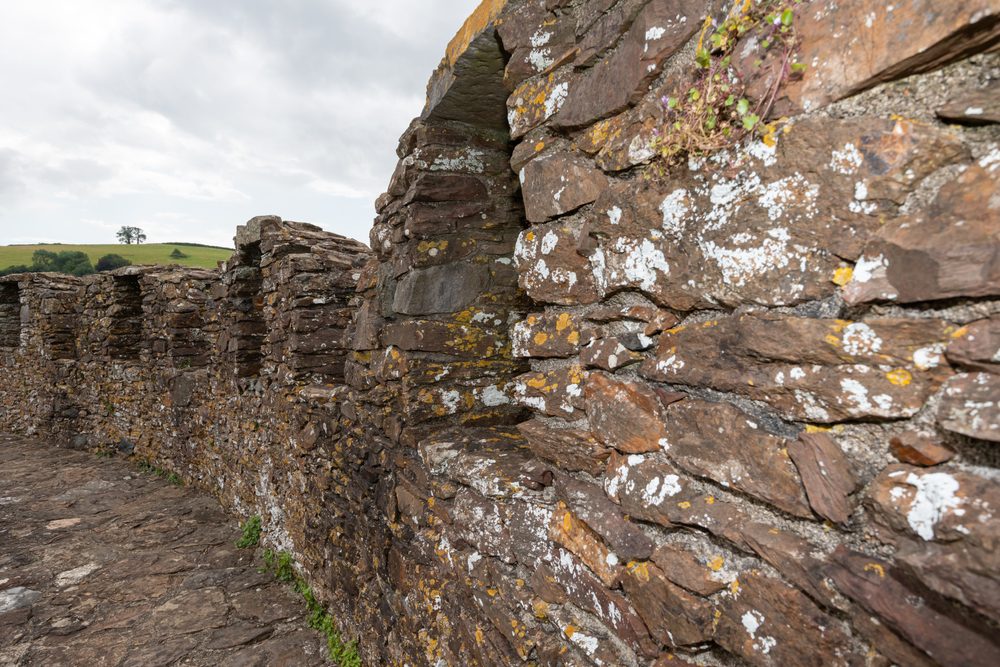
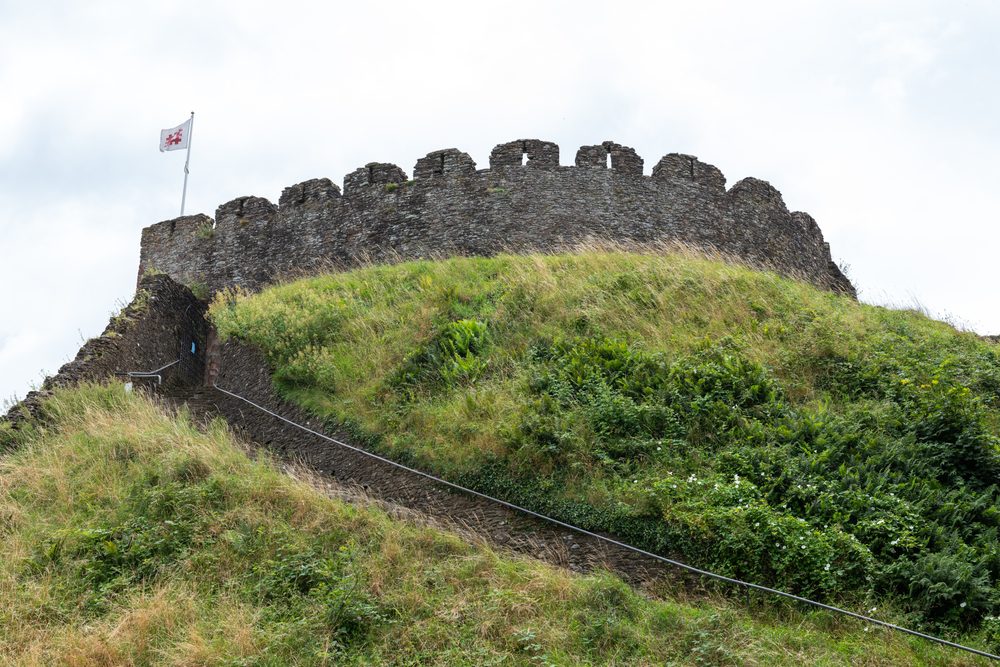
Images Supplied and licensed from Shutterstock Standard Licence Package
Totnes Castle Facts
Visitors will find graffiti on the inner bailey trees that WWII prisoners inscribed while prisoners of war in the area.
One of the trees in the castle bailey is a Holm Oak that is 150 years old and reaches the height of the castle keep. 'Holm' is the ancient word for a Holly tree.
From the vantage of the keep height, you can trace the centuries of architecture in the town below, including the Saxon built High Street flanked by poultry walk and Butterwalk, which mark the site of the ancient marketplace.
Visitors will find the remains of a small room remaining in the castle called a Garderobe.
Amongst the more innocent uses was the storage area from which our modern word 'wardrobe' has its origins. The less savoury service was a primitive latrine where occupants eliminated human waste into the moated area below.
Thirty-four merlons span the top of the castle keep, solid areas of battlement interspersed by crenels or arrow slits. When a series of crenels follow in succession, it refers to the word often used in castle literature: 'Crenellated."
Totnes Castle Q&A
What Kind of Castle Is Totnes Castle?
Totnes Castle is a fine example of a motte and bailey Norman castle and replaced an earlier earth and woodwork structure on the site. The original castle symbolised Norman dominance over the local Saxons and followed shortly after the Norman Conquest of the area by Wiliam I. William de broase, who claimed descendants from the Breton knight Juhel took back the castle.
Historians believe that his son, Reginald de broase rebuilt the castle in the 13th century with stone in stone and that the del la Zouche clan built the stone shell keep and walls in the 14th century.
How Old Is Totnes Castle?
Although Totnes castle is 953 years old, the first Totnes castle in 1067 was an earth and timber structure, little of which remains today. Reginald de Braose first rebuilt the wooden castle in stone in the mid-1300s. The de la Zouch family rebuilt the castle extensively in the 14th century, with a new shell keep on view today.
The earliest remains are the motte and bailey earthworks are the masonry foundations on top of the motte—the foundations of the square tower date back to the 11 century to the 12th-century. The surviving stonework is mainly of 14th origin and includes the circular shell keep and section of the bailey wall.
Who Built Totnes Castle?
The Briton Knight Juhel built the first motte and bailey castle out of wood and earthwork shortly after the Norman Conquest of England. A close ally of William I, Juhel chose to place the castle amid a thriving Saxon Village close to the navigable source of the River Dart.
The castle was a symbol of Norman control over the Saxon populace and a centre of administration of Norman rule. The de Broase clan were the first to replace the wooden fort with stone in the mid-1300s, and the de la Zouch family rebuilt the circular stone tower and part of the castle walls we see today.
Location of Totnes Castle
Totnes castle ruins include parts of the shell keep, motte and two baileys relatively unaffected by modern developments. Juhel placed the first build on high ground overlooking the navigable reaches of the River Dart and Totnes town.
The River Dart was an essential point of sea access at the time, and the site also commanded a presence at the major trade and travel routes into Bath and areas beyond. Juhel stamped his Norman authority over the local populace by imposing his castle over the thriving Saxon town.
The castle didn’t serve any essential military function, nor was it a primary seat of noble residence which means the site mains remarkably unchanged from its original layout. The 13th century stone build followed the lines of the previous earth and timber structure with the addition of a shell stone keep.
Other Places To Visit Near Totnes Castle
St Mary's Church, Totnes
St Mary's Church, Totnes was once attached to a Benedictine priory with close ties to Totnes Castle. The same Breton Knight Juhel who built the first Totnes Castle also established the priory that once stood to the Northeast of St Marys.
Although the church dates back to the mid 15th century, historians believe it stands on a much older worship site. The tower of St Marys rises 120 feet (36.5m) high, and it's a landmark in the area.
The tower boasts a series of carvings and the distinctive marks of arrow sharpening from the 1360s when Edward II declared archery practice compulsory on Sundays.
The church has an intricately carved Tudor door and an octagonal font from the 14th century topped with a Jacobean cover.
Berry Pomeroy Castle
The Berry Pomeroy Castle is dramatically placed on a steep hillside and ominously portrays its designation as one of the most haunted castles in England. The first manor house dates to the 13th century, but the castle is a 16th-century built by the Pomeroy clan.
The Pomeroys owned the site since the Norman invasion, and historians credit Henry Pomeroy as the builder of the fortified castle. He likely fortified his manor at the time due to the threat of French invasion as his estate stood only a few miles off the coast.
The Somersets were the only other owners of the estates since its purchase in 1537. Their family abandoned Berry Pomeroy in the late 1600s when the family moved residence.
Compton Castle
Compton Castle is a beautiful example of a fortified manor house with turrets and parapets galore. Although under the care of the National Trust, it’s home to the Gilbert family, who are descendants by marriage to the de Compton family, who initially held the land.
Since 1329 the Gilberts have added, altered and renovated the grand manor house castle.
The original manor house dates back to the mid 14th century, while the fortifications date to 1520 under the supervision of John Gilbert. Visitors may view the Great Hall, kitchen and solar as well as the barn and chapel. The castle also has a beautiful rose garden and an orchard.
Sources
- Historic England: Totnes Castle
- English Heritage: Totnes Castle
- Castles Forts Battles: Tones Castle
- National Trust: Compton Castle
- Wikipedia: Totnes Castle
- Gatehouse Record: Totnes Castle
- Historic UK: Totnes Castle
- Wikipedia: St Mary's Church Totnes
- Wikipedia: Merlon
- English Heritage: Guidebook: Berry Pomeroy Castle
- Wikipedia: William de Braose, 3rd Lord of Bramber
- Splashdown: Splashdown Quaywest
- Paignton Zoo: Home
- Premier Inn: Paignton Seafront (Goodrington Sands) hotel
- The Steam Packet Inn: Home
- English Heritage: Home
- English Heritage: Opening Times at Totnes Castle
